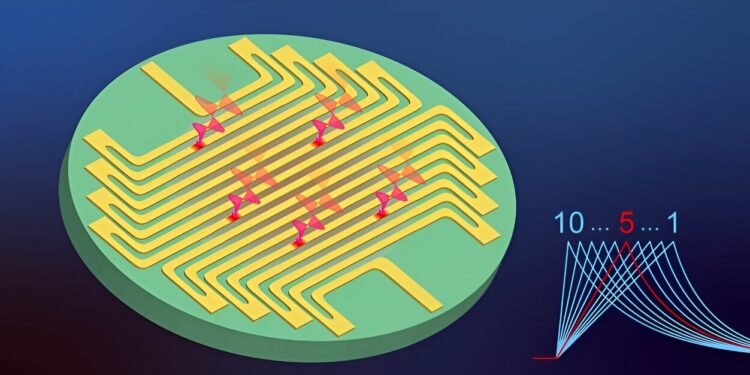Superconducting microstrip photon number resolution detector. Credit: Kong (SIMIT).
The use of single photons as qubits has become an important strategy in the field of quantum information technology. Accurately determining the number of photons is crucial in various quantum systems, including quantum computing, quantum communication, and quantum metrology.
Photon number resolution detectors (PNRDs) play a critical role in achieving this precision and have two main performance indicators: resolution fidelity, which measures the probability of accurately recording the number of incident photons , and the dynamic range, which describes the maximum resolvable photon. number.
Superconducting nanostrip single photon detectors (SNSPDs) are considered the state-of-the-art technology for single photon detection. They offer near-perfect efficiency and high-speed performance.
However, when it comes to photon number resolution, SNSPD-based PNRDs have struggled to balance fidelity and dynamic range. Existing array-type SNSPDs, which divide incident photons between a limited number of pixels, face fidelity constraints. These detectors are thus called quasi-PNRD.
SNSPDs work by breaking the local superconductivity of a narrow, cooled, current-biased band when a photon is absorbed. This creates a local resistive region called a hot spot, and the resulting current is diverted through a load resistor, generating a detectable voltage pulse.
Therefore, an SNSPD with a sufficiently long superconducting band can be considered as a cascade of thousands of elements, and n photons simultaneously activating different elements should generate not non-overlapping hot spots. However, conventional SNSPDs combined with modified cryogenic readouts can only resolve 3–4 photon numbers, resulting in low dynamic range.
Resolution of the number of photons in a SMSPD: (a) Histograms (points) and Gaussian fit (lines) of the rising edge time of the response pulses under pulsed laser illumination with an effective average number of photons at 2.5 and 5.1 . The colored areas represent the decomposed Gaussian functions. (b) Confusion matrix illustrating the probabilities of assigning n detected photons to m reported photons, where the diagonal terms represent the fidelity of photon number reading. (c) Photon counting statistics reconstructed from pulse rising edge time distributions at different effective mean photon numbers ranging from 0.05 to 5. Measured photon counting statistics (colored bars) align closely with the Poisson statistics of the consistent source (dotted lines). ). Credit: Kong, Zhang et al., doi 10.1117/1.AP.6.1.016004,
As shown in Advanced PhotonicsResearchers from the Shanghai Institute of Microsystems and Information Technology (SIMIT), Chinese Academy of Sciences, have made progress in improving the photon number resolution ability of SNSPDs.
By increasing the bandwidth or total inductance, they were able to overcome the bandwidth limitations and timing jitter of the readout electronics. This resulted in stretched rising edges and an improved signal-to-noise ratio in the response pulses, and therefore improved readout fidelity.
By expanding the superconducting band to the micrometer scale, the researchers presented the first observation of real photon number resolution of up to 10 using the Superconducting Microstrip Single Photon Detector (SMSPD). Surprisingly, they obtained these results even without using cryogenic amplifiers. Readout fidelity reached an impressive 98 percent for 4-photon events and 90 percent for 6-photon events.
Additionally, the researchers proposed a dual-channel timing setup to enable real-time photon count reading. This approach significantly reduced data acquisition requirements by three orders of magnitude and simplified the readout setup. They also demonstrated the utility of their system in quantum information technology by creating a quantum random number generator based on parity sampling of a coherent state.
This technology guarantees impartiality, robustness against experimental imperfections and ambient noise, as well as resistance to eavesdropping.
This research represents a significant advance in the field of PNRD. With further improvement in the detection efficiency of SMSPDs, this technology could become easily accessible for various optical quantum information applications. These results highlight the potential of SNSPDs or SMSPDs to achieve high-fidelity, wide dynamic range photon number resolution.
More information:
Ling-Dong Kong et al, Large inductance superconducting microstrip photon detector allowing resolution of 10 photon numbers, Advanced Photonics (2024). DOI: 10.1117/1.AP.6.1.016004
Quote: Unleashing quantum precision: extended superconducting bands for improved photon counting accuracy (February 9, 2024) retrieved February 9, 2024 from
This document is subject to copyright. Apart from fair use for private study or research purposes, no part may be reproduced without written permission. The content is provided for information only.



